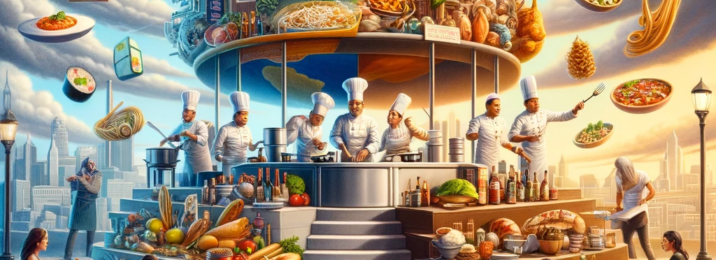The Evolution of Mexican Cuisine in the Global Culinary Scene
Mexican cuisine has transcended its regional boundaries to become a dynamic and integral part of the global culinary landscape, evolving through a complex interplay of historical influences, cultural exchanges, and innovative adaptations.
Historical Roots and Global Journey
Mexican cuisine’s journey from its indigenous origins to a global phenomenon is a testament to its adaptability and appeal. The Aztecs and Mayans laid the foundation with corn, beans, and chili peppers, which remain central to Mexican cooking. The Spanish conquest introduced new ingredients like dairy, rice, and meats, creating a fusion that would evolve into the Mexican cuisine we recognize today.
The Spanish Influence
The 16th-century Spanish colonization brought about a culinary revolution in Mexico, introducing livestock, dairy, and a variety of European staples. This melding of cultures gave rise to dishes that would become cornerstones of Mexican cuisine.
Indigenous Contributions
Despite the European influence, indigenous ingredients and techniques have persisted, ensuring that traditional Mexican dishes retain their authenticity and cultural significance.
Globalization and Adaptation
By the 20th century, Mexican cuisine began to spread globally, propelled by industrialized food technology, complex distribution techniques, migration patterns, and cultural shifts. Tex-Mex, a fusion of Mexican and American flavors, emerged as a global trendsetter.
Tex-Mex and Beyond
Tex-Mex cuisine’s rise in the 1980s and 1990s marked the beginning of Mexican food’s global journey. It paved the way for Mexican chefs to introduce regional Mexican cuisine to the world, adapting it to contemporary culinary trends.
The Street Food Movement
Mexican street food, with its tacos, burritos, and quesadillas, has influenced the global street food culture, leading to the proliferation of food trucks and pop-up stalls.
Cultural Exchange and Fusion
Mexican cuisine has significantly influenced international cuisine by introducing ingredients like chili peppers, corn, tomatoes, and avocados. This has transformed global cooking practices and led to the creation of innovative fusion dishes.
Tex-Mex’s Global Impact
Tex-Mex has not only been successful in the United States but has also influenced the creation of new dishes worldwide, adapting its flavors to local food traditions.
The Role of Immigrants
Mexican immigrants have played a crucial role in spreading their culinary traditions, leading to the establishment of Mexican restaurants and the integration of Mexican flavors into various cuisines.
Modern Innovations and Trends
Contemporary Mexican cuisine is characterized by a blend of traditional methods and modern innovations. Chefs are experimenting with new ingredients and techniques, pushing the boundaries of traditional Mexican food.
The Rise of Fusion Cuisine
Fusion cuisine, combining elements from different culinary traditions, has gained popularity, with Mexican flavors often at the forefront of this trend.
Authentic Regional Cuisine
There is a growing appreciation for authentic regional Mexican cuisine, with restaurants specializing in specific regional dishes and cooking techniques.
The Role of Mexican Ingredients
Unique Mexican ingredients have found their way into global cuisine, adding new flavors and textures to dishes around the world.
The Michoacán Paradigm
The Michoacán region’s traditional cuisine has been recognized by UNESCO as an intangible cultural heritage, highlighting the global significance of Mexican culinary practices.
Mexican Cuisine’s Future Prospects
The future of Mexican cuisine in the global culinary scene looks promising, with its continued influence on fusion foods, street food revival, and innovative food delivery services.
The Influence of Mexican Culinary Workers
The significant contribution of Mexican workers in restaurant kitchens across the U.S. and beyond has been pivotal in the dissemination and evolution of Mexican cuisine.
Conclusion
Mexican cuisine’s global ascension is a story of resilience, creativity, and cultural pride. It has not only enriched the world’s culinary repertoire but has also become a symbol of Mexico’s vibrant culture and history.
FAQs
What makes Mexican cuisine so popular worldwide?
Mexican cuisine’s popularity stems from its bold flavors, vibrant colors, diverse ingredients, and the unique combination of spices, meats, and corn-based staples. Its adaptability to local tastes and the global street food movement have also contributed to its worldwide success.
How has Mexican food influenced international cuisine?
Mexican food has introduced new ingredients and flavors to international cuisine, such as chili peppers, corn, tomatoes, and avocados. It has also inspired the creation of fusion dishes and influenced global cooking techniques and concepts.
Are Mexican restaurants successful worldwide?
Yes, Mexican restaurants and food chains have found success globally due to their vibrant flavors, rich spices, and ability to adapt to local tastes while maintaining authentic flavors. The popularity of Tex-Mex cuisine has also contributed to their success.
What are some unique Mexican ingredients used in global cuisine?
Unique Mexican ingredients used globally include chili peppers, corn, tomatoes, avocados, and spices like cumin and coriander. These ingredients have become staples in various cuisines, transforming global cooking practices.






